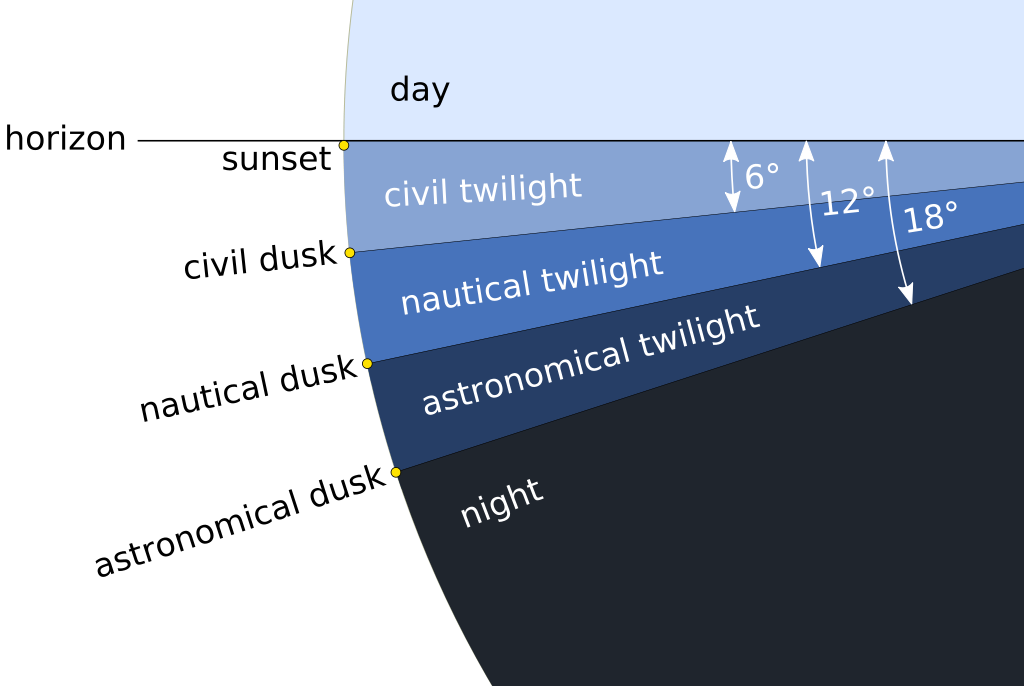
 Orion is proud to partner with BBC Sky at Night Magazine, the UK's biggest selling astronomy periodical, to bring you this article as part of an ongoing series to provide valuable content to our customers. Check back each month for exciting articles from renowned amateur astronomers, practical observing tutorials, and much more!
Orion is proud to partner with BBC Sky at Night Magazine, the UK's biggest selling astronomy periodical, to bring you this article as part of an ongoing series to provide valuable content to our customers. Check back each month for exciting articles from renowned amateur astronomers, practical observing tutorials, and much more!
The Three Types of Twilight
The period between 'day' and 'night' is complex, and so is the sky at this time.

By Pmurph5 (Own work) [CC BY-SA 4.0], via Wikimedia Commons
The changes that occur during dusk can be as striking as anything we observe in nature. Everything we can see changes, as the brightness of the sky drops to less than 3/10,000ths of a per cent of its intensity at sunset. Yet this daily spectacle is often lost to us, perhaps obscured by cloud, but also obliterated by artificial lighting and sometimes simply ignored because of its regularity.
Twilight is not a single, fixed state, but a gradual change that has three distinct phases. The first is civil twilight, which begins as the upper limb of the Sun disappears below the horizon and ends at civil dusk, when the geometric center of the Sun is 6° below the horizon. During this period, you can carry on doing things much the same as if the Sun were above the horizon, lit only by the still-blue overhead sky. The first half an hour being dubbed by photographers as the 'blue hour'.
We tend to look to the west at sunset, drawn by the coral pink hues above the horizon, and miss the more dramatic changes that are happening behind us. Here, we see a band of more muted amaranth pink, dubbed the Belt of Venus, illuminated by red sunlight that is not scattered in its passage through the atmosphere. Below is a rising purple swathe, that part of the visible sky that is in Earth's shadow. During civil twilight, only the very brightest stars and planets become visible.
Civil dusk signals the beginning of nautical twilight, which persists until the geometric center of the Sun is 12° below the horizon — nautical dusk. At nautical dusk, it's sufficiently dark that a sailor at sea would not be able to see the horizon, hence its name. Our monochrome scotopic (low light) vision begins to dominate and colors fade as everything on land takes on shades of grey. The purple in the east merges with darkening sky above. First-magnitude stars begin to appear. Initially they seem lonely points of light, but they gradually multiply as the sky darkens and fainter stars join them. Eventually, the entire Plough asterism in Ursa Major appears, pointing to Polaris, so at last we can polar align our equatorial mounts. Night is approaching, but the sunlit sky is still visible on the sunset horizon. The third phase, astronomical twilight, is beginning.
Light's last gasp
As the Sun descends past nautical dusk and into astronomical twilight, when our star is between 12° and 18° below the horizon, its illumination is replaced by other sources. For too many of us, this is the skyglow from artificial light, but even in unlit places on a Moonless night the sky is never completely dark. The combination of an imperceptibly faint auroral glow, the zodiacal light (sunlight reflected off interplanetary dust particles), and the light of diffuse matter in our Galaxy all contribute, though their contribution is less than that of a single mag. +6.5 star if it was distributed over an area the size of the Moon.
Astronomical dusk takes place when the Sun's geometric center drops to 18° below the horizon. Above our heads we will see, with dark-adapted eyes, objects as faint as we are likely to. Away from light pollution, the Milky Way shows structure sculpted by the dust of dark nebulae. The Andromeda Galaxy and the Double Cluster in Perseus may show themselves even without binoculars. The varied colors of stars become more apparent, and our awareness of the existence of artificial satellites and sporadic meteors grows. The glittering sky-dome above our heads appears to have come closer. This is night.
Then, all too soon, it is over. The sky brightens, the stars fade, the twilight phases play out in reverse. Dawn, and a brand-new day, is upon us.
Copyright © Immediate Media. All rights reserved. No part of this article may be reproduced or transmitted in any form or by any means, electronic or mechanical without permission from the publisher.






 /
/ 







